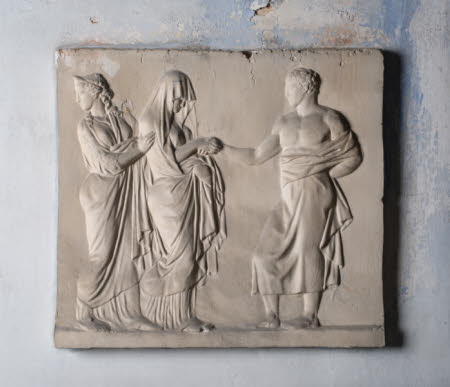Plaster cast of the Marriage of Peleus and Thetis.
Category
Art / Sculpture
Date
1800 - 1825
Materials
Plaster, painted
Measurements
600 x 485 x 50 mm
Order this imageCollection
Knole, Kent
NT 128693
Summary
Described as the marriage of Peleus, hero of Thessaly in Greece and the sea nymph Thetis. This event is famous for being the cause of the Trojan War. All the gods were invited except one: Eris, the goddess of discord. Angered by this insult, she appeared anyway and caused chaos by throwing an apple with the inscription “for the most beautiful" into the crowd, setting the goddesses Juno, Venus, and Minerva against each other.
Full description
The plaster relief shows a veiled woman being presented to a bare-chested man. The two are holding each other by the right hand (dextrarum lunctio), indicating that a wedding vow is being made. Another woman presents her to the man. Both female figures have their skirts held up in front of them, suggesting that they are outdoors. The original image is from a first century AD terracotta tile in the Louvre (CP 4172), part of the Campana collection (acquired in 1861). Another copy of this scene is the Attingham Grisaille painting (1793-5) by Robert Fagan (1745 – 1816), designed as an overdoor for the entrance hall of Attingham Park (NT. 609083). We know that this was based on an engraving entitled "Nova Nupta" (Fig. 57) in Pietro Santo Bartoli's 'Admiranda Romanarum Antiquitatum' [Record of the Antiquities of Ancient Rome] published in 1693, when the tile was in the Aedibus Farnesianis [Farnese Family Villa] in Rome. The book contains eighty-two etchings showing a selection of ancient Roman reliefs, sarcophagi, and paintings, and was the standard work for the representation of images from antiquity for artists and collectors, etc., and is also likely to be the model for the cast in Knole.
Provenance
Possibly acquired by Charles, 1st Earl of Whitworth (1752-1825)
Credit line
National Trust Collections (Knole, The Sackville Collection)
